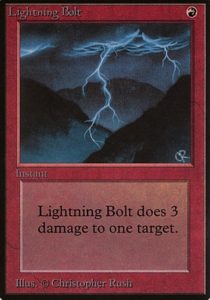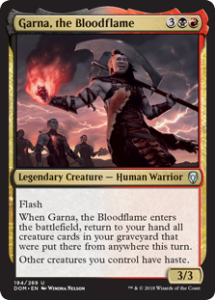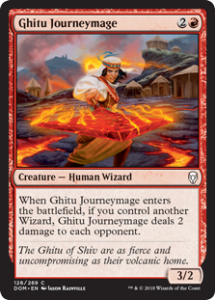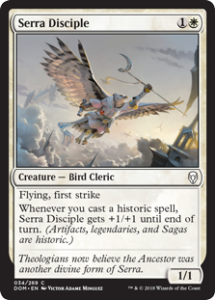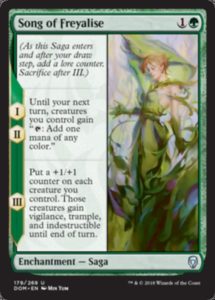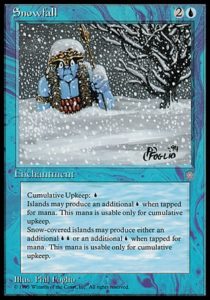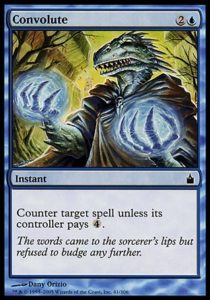Dominaria Limited is not an easy nut to crack. Ixalan, Amonkhet, and the rest weren’t solved in a day, but Dominaria is quite different from the Limited formats we’ve seen lately. The removal is strong, the creature quality of uncommon legends is through the roof, the synergies are more diffuse, and the mechanics are more broad.
I’ve been playing quite a lot of Dominaria to prepare for this weekend’s Grand Prix Columbus, and the format may rank among the more difficult Limited (and Team Limited) formats I’ve ever played. Today I’d like to talk about why this the case.
Something Old & Something New
Dominaria feels like a synthesis of older Limited formats and contemporary development paradigms. Removal is quite good (though not as insane as it was at common seven years ago), but so are creatures (which feel like contemporary large common creatures). Combat tricks are weaker than they’ve been in years, but they still have utility. All of these factors make Dominaria rather inscrutable: you can’t just compare it to Amonkhet or Invasion—it’s got some of both.
Rare Deflation
Dominaria is a bomb-heavy format kicked into overdrive. Not only are there are a whole slew of powerful rares and mythics, but we’re seeing cards that might normally be mythic pushed down to rare (like Shalai, Voice of Plenty) and rares pushed down to uncommon (like all of the non-Rona multicolor uncommon legends—just look at all of that text on Garna!). There is a ton of raw power in Dominaria, likely enough to make decks more reliant on it than synergy. On the surface of things, this should make the format simpler—play bombs and win. However, if everyone is cooking with dynamite, then the format is about navigating the minefield of bombs each player has.
How does Aggro Work?
Aggro has been quite good in most recent large sets. One of the easiest ways to beat bombs is to go underneath them—if your opponent doesn’t have time to deploy and utilize their bombs, then they’re not very good, are they?
The obvious tempo-aggro deck is Wizards. They have a simple goal: curve into Ghitu Journeymage and Academy Journeymage. Keep the the opponent on the back foot and applying the pressure. The problem is Wizards has scant aggressive one- or two-drops to enable such a start. Merfolk Trickster is a color-intensive uncommon. Naban, Dean of Iteration is a rare. And that’s it for cheap Wizards with more than 1 power. Vodalian Arcanist, Ghitu Chronichler, and Ghitu Lavarunner are not very exciting or aggressive. They encourage a heavy spell density rather than curving out into creatures.
Wizards ultimately are an A+B tribe: they need a high density of spells to function, but most spells you cast will slow or blunt your aggressive plan. You can’t fill your deck with top tier spells like Shivan Fire, so you’re encouraged to chain cards like Opt (which is durdly), Divination (which is very durdly), and Radiating Lightning (which is fine, but unexciting). I’ve seen a bunch of UR Wizards decks so far, but the best ones lean on powerful spells rather than pushing through damage.
The blue aggressive potential doesn’t end with Wizards. Arcane Flight has packs a punch, as we’ve seen Cartouche of Knowledge and One With the Wind do a ton of heavy lifting in Limited. Dominaria’s removal is decent, but there’s not a ton of ways to profitably kill a 3 toughness creature without spending 4-5 mana. Sure, it’s not Spectral Flight, but there’s a chance of a badstuff Sligh deck that will go under everything.
Red, white, and black are the more obvious aggressive colors. My take on the format, particularly Sealed, is that black and red are quite deep and their powerful removal support controlling strategies better than they do disruptive aggro. But that’s an argument for another time. White is a broad color which has many interactions with historic, so let’s talk about that mechanic.
Historic matters?
Dominaria’s archetypes seem to be loose, particularly compared to what we’ve seen in Ixalan. Historic-matters, which is in Esper colors, does a good job of underscoring this. Normally, archetypes are centered around context-sensitive cards whose power grows when you build around them. The classic example is Spider Spawning, a deck that combined unplayably bad cards and when properly built was the best deck at the table. In Dominaria, archetypes may be more diffuse and relevant. Historic is perhaps the best example of this, as it’s broad and supported in a variety of colors.
Historic rewards you for playing artifacts (which tend to be overcosted to compensate for their flexible mana costs), Sagas (which tend be good but fluctuate wildly in power level), and legendaries (which tend to be the most powerful creatures in the format, and also planeswalkers). The best historic decks are probably going to max out on legendaries, however that means the best historic decks are full of bombs. That rewards raw power more than it does synergistic deckbuilding—legendary cards are almost consistently amazing, so they’re going to generally be the best cards in your deck. The synergy they generate with historic-matters is incidental, since you’re being rewarded for drawing your best cards rather than cards you put in your deck for synergy’s sake. Historic-matters seems to be less a guidepost and more a method of snowballing by having lots of good cards make each other even better.
Sagas
Sagas are hard to evaluate properly. Sure, some like Phyrexian Scriptures are just nuts and others like Chainer’s Torment are slow and easily answered; but sagas as a mechanic are hard to evaluate. They’re Rebound spells with different effects each time and make you wait two who turn cycles to get the full effect. (They also work in very odd ways to make them function better on MODO, but that’s neither here nor there.)
By and large, Sagas seem designed to help you snowball: Song of Freyalise lets you dump your hand and then get a super-safe Overrun. Triumph of Gerrard is an Ordeal of Heliod that helps you win a race. Even The Eldest Reborn only functions well when you’re at parity or ahead.
Legendary Sorceries
There are only six of these and they vary widely in power level, both individually and as a mechanically. Yawgmoth’s Vile Offering is nuts whereas Urza’s Ruinous Blast can’t kill your opponent’s best stuff, and you can’t rely on casting any of them when you need to. They continue the theme we’ve seen with historic-matters: play legendary creatures to win. They reward you for having a powerful creature in play by letting you get even further ahead. Or, as we call it:
Snowballing
This is a game/game design term that means to compound your victory. Having a small advantage yields a larger advantage, which then inevitably leads to victory. Everything I’ve experienced about Dominaria suggests that the format is about sticking a bomb (or the first unanswered bomb) and then running away with the game. There are a variety of methods of doing this, as there are both a ton of insane creatures and the overwhelming potential of most sagas. Removal is crucial, since even an unanswered Slimefoot, the Stowaway can take over the game, but the density of bombs in Dominaria is potentially higher than in any set ever before. You can’t just expect to kill all of your opponent’s threats and eke out victory off a kicked Academy Drake (though that’s both sweet and something I’ve died to)—you need to be leveraging your own bombs or applying consistent pressure (and given the quality of common creatures, seems difficult to do) in order to not get buried in advantage.
Team Sealed
This team sealed format is tough. A lot of the common creatures seem underpowered, particularly considering what we’ve grown accustomed to. There aren’t the crazy three-power creatures for two like Gust Walker or even Tilonali’s Knight. There aren’t powerful aggressive mechanics like Exert or strong tribal themes like Merfolk. Thus there’s no clear aggressive archetype to bank into. (I’ve got some ideas, but haven’t been impressed by any of their executions just yet).
This means deckbuilding is a matter of dividing all of your bombs up, but even in a high power format like Dominaria, it’s rare that you’ll be able to field three powerful decks. This is complicated by all decks wanting to skew towards control and the dearth of fixing. For all people playing in a team sealed event, I strongly encourage you to practice deckbuilding with your team and drafting to see how the archetypes’ best expressions look—that’s what I’ll be doing all of this week.
And that’s a brief overview of where the format’s at right now. For all I know, I could be wrong and UR tempo Wizards is amazing. But I’ll be pretty surprised if that’s the case, particularly this early when people are overvaluing Academy Journeymage. Here’s hoping we can crack the format this weekend!
And, as always, thanks for reading.
—Zachary Barash
Zachary Barash is a New York City-based game designer. He works for Kingdom Death: Monster, has a Game Design MFA from the NYU Game Center, and does freelance game design. When the stars align, he streams Magic.
His favorite card of the month is Skymark Roc. It’s painfully good when played on curve but isn’t unbeatable. It even tells a nice little story—it delivers your opponent a present as it’s clawing at their eyes.

